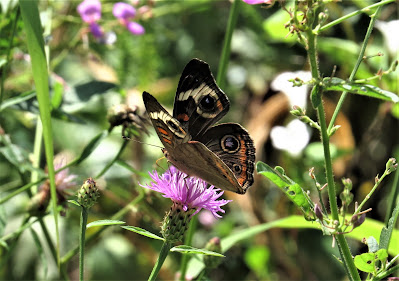Lawn Mowing: An
Injustice to Nature
 |
| If people would leave grass on slopes instead of cutting it (and any wildflowers growing there), they would allow the vegetation to prevent erosion and preserve water within the soil. |
ALL TEXT AND PHOTOS © Marlene A. Condon
Spring has sprung
The mowing’s begun.
Swards of green
No blooms to be seen.
No food to find
By bees and their kind
Because humans are
blind.
I’ve always loved
springtime with its obvious awakening of so many life forms. But over the past
few years, I’ve come to dread it.
Whereas I used to mostly hear
the songs of birds and, in season, insects and frogs, I now hear the incessant
sound of lawn mowers from 8 AM to almost 8 PM from Monday to Friday, and
sometimes even on the weekend. People seem to be obsessed with short grass that
is cut close to soil level, which isn’t good for its own health nor the health
of our pollinators.
When grass is cut, all the
blooming wildflowers growing with it are also cut, leaving our bees,
butterflies, flies, and other pollinators with no nourishment to sustain them.
Is it any wonder, then, that these insects are in trouble and disappearing?
Sadly, humans tend to live in their own bubble and are blind to the numerous
life forms around them that require these flowering plants in order to survive.
And it’s vital for humans that they do survive.
If you grow your own
fruits and veggies, you’re indebted to pollinators for helping your plants to
be productive. If you purchase this kind of food from farm vendors and/or
grocery stores, or if you eat a meal at a restaurant, you can be grateful to
pollinators for providing the produce you bring home or eat on the spot.
Most folks have lawns, but
they don’t understand the connection between the wildflowers that show up there
and how helpful they are to wildlife. Many people might even get rid of these
plants altogether by way of pesticides, another action highly detrimental to
our insects and other kind of critters.
These situations are
commonplace in suburbia, where everyone follows the lead of others, as in the
expression: Monkey see, monkey do. It would be nice if someone within the
community could explain to others the importance of keeping wildflowers instead of
viewing them as “weeds” (I very much dislike this word) to be gotten rid of. It
just takes one person to open the eyes of at least some of the neighbors.
Strangely, mowing is
commonplace in the rural area where I live, and there’s not even much lawn to
be seen on many properties! What can be seen not far from my property,
however, is a huge vineyard and several horse farms, places where I wouldn’t
expect people to need to mow grass or pesticide it much. Horse farms have
pastures to feed horses, and vineyards maintain row upon row of grape vines.
But they are totally in sync with suburbia! Nowadays farms are every bit as
manicured as any yard in developed areas.
Years ago, however, farms
were wonderful places to find wildlife. As a young girl and even as a teenager,
I spent many a day at local farms located within the small town where I grew
up. I did the same in college, having attended a university also located within
a small town in a rural area. Farms back then had places that were not
maintained, creating habitat for all kinds of animals.
With a booming human
population, I’m not sure where people expect wildlife to live and thrive. But
in the case of pollinators, we can certainly make room for them on our
properties. We just need to stop mowing so darned often (taller grass results
in healthier grass anyway) so wildflowers can survive long enough to feed
insects. Better yet would be to get rid of most of the lawn to grow only
flowers, or to allow a section of the yard to “grow wild”. If people recognized
the value of wildflowers and wildlife, I feel certain most of them would do things
differently.
NATURE ADVICE:
You can help to
change people’s attitudes regarding lawn care by writing letters to the editor
in newspapers and other publications, and by writing to government officials at
every level. Explain the value of “weeds” and request that these plants not be
pesticided in lawns (private or public) and that mowing occur less often
(preferably no more than once every two weeks). Folks need a leader to remind
them that we share the Earth with other creatures and to inform them how to
support those other life forms. You can be that leader.



